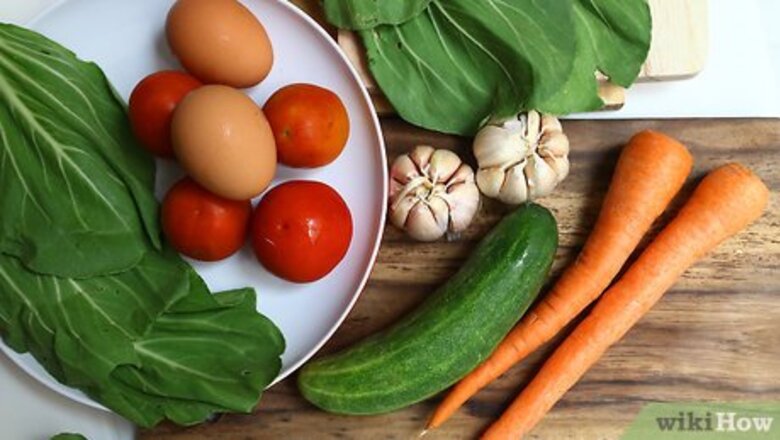
views
How to Enhance Your Cooking and Your Recipes

Use fresh ingredients whenever possible, and don't forget to wash the vegetables beforehand. When shopping for fresh produce or meats, be certain to take the time to ensure that the texture, colors, and quality of the food you buy is the best in the batch. You should also try to stick to cooking with foods that are currently in season, as that is when they taste their best. If you're just starting to cook, don't substitute ingredients. The unfamiliar ingredient might interact with the other food in a way that you're not aware of and ruin the entire meal.
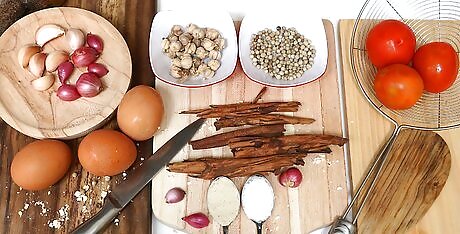
Organize your tools and ingredients before cooking. The practice of getting all of your tools and ingredients together, prepared, and measured is called "mise en place" by professional chefs, and is considered essential to efficient cooking. Your "mise en place" should be ready and close at hand before the stove is turned on. Unless otherwise noted in your recipe, cut the food into uniform slices or pieces so that they cook evenly. There are a wide variety of cutting techniques—chopping, dicing, cubing, slicing, julienning, etc. The bigger the pieces, the longer they'll usually take to cook.
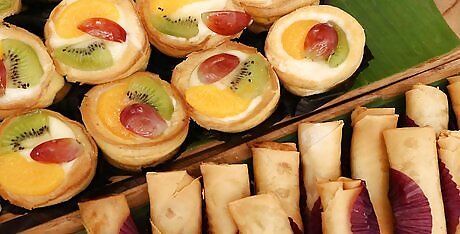
Include contrasting textures in your meals. Some of the most enjoyable dishes include a combination of different yet complementary textures. These textures work together in your mouth to make eating a more enjoyable experience. Think about topping off a baked pasta or vegetable dish, such as macaroni and cheese, or eggplant parmigiana with some bread crumbs. Similarly, adding some chopped scallions or celery to mashed potatoes can add a pleasant burst of texture and flavor.
Season your food with salt and pepper. Adding the right amount of salt and pepper is the easiest thing you can do to improve the taste of your food. A dash of salt and pepper can really make the flavors of a dish come alive, bringing out the best in each individual ingredient. If you're uncertain about quantities, or afraid of adding too much salt, the best thing you can do is taste! Add a little salt, taste, add a little more, taste...and so on, until the flavor is just right. It's how professional chefs do it. Sprinkle salt onto joints of meat or a whole chicken before roasting, add a little to stews and sauces while cooking, and remember to generously salt the water when boiling pasta, rice and potatoes. EXPERT TIP Alex Hong Alex Hong Executive Chef & Restaurant Owner Alex Hong is the Executive Chef and Co-Owner of Sorrel, a New American restaurant in San Francisco. He has been working in restaurants for over ten years. Alex is a graduate of the Culinary Institute of America, and has worked in the kitchens of Jean-Georges and Quince, both Michelin-starred restaurants. Alex Hong Alex Hong Executive Chef & Restaurant Owner It's all about the basics. Alex Hong, a chef who's worked in Michelin-starred restaurants, says: "The two most important flavors in cooking are salt and acid. For instance, if you're making a salad dressing, it's going to be flat if there's not enough acid, so you might add vinegar or lemon juice. And it's not going to taste like anything if there's no salt to bring out all the flavors."
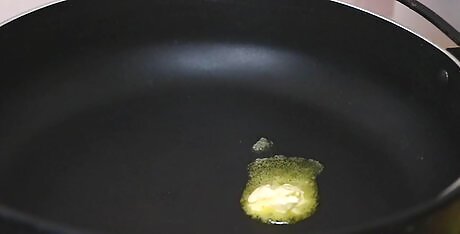
Use butter in your cooking. Butter adds a delicious, creamy, slightly nutty flavor to food and should be featured heavily in many types of cooking and baking. Use butter anytime a recipe calls for it, and even sometimes when it doesn’t! Butter can be used as a cooking medium, like in sautéing, where it both complements and enhances the natural flavors. It can be used as the base for sauces, where it adds a wonderfully smooth, creamy texture. Or it can be used in baking, where it provides a wonderfully flaky, melt-in-your-mouth quality.

Build a repertoire of go-to sauces. A good sauce can transform a dull, flavorless dish into something much more exciting and delicious. By learning a few basic sauce recipes, you can kick your cooking credentials up a few notches, with very little effort. A few sauces you can make include: Béchamel sauce: this is a white, creamy sauce which forms the basis of many dishes - including vegetable gratins, cheese soufflés and numerous pasta sauces. Velouté: This is another simple sauce made by combining a roux with a flavored stock. Depending on the flavor of the stock, this sauce can be adapted to accompany chicken, fish or veal. Marinara: Marinara is a bold tomato sauce used in Italian and Mediterranean cooking. It combines fresh or canned tomatoes, onions and a variety of herbs, and is used in many pizza and pasta sauces. Hollandaise: This buttery, lemony sauce is the perfect accompaniment to seafood, eggs and vegetables. It is made by combining clarified butter, egg yolks and lemon juice to form an emulsion. Other sauces you can experiment with include: barbecue sauce, garlic cream sauce, chili sauce, sweet and sour sauce, cheese sauce and chocolate sauce.

Experiment with herbs. Herbs can single-handedly give a dish a distinct flavor, characterizing it as belonging to Greek, Italian, Mexican, Chinese, or any other type of world cuisine. Herbs enhance the flavor and color of food, making it more exciting to cook and eat. Basil is used most often in Mediterranean cooking and pairs perfectly with tomatoes. It can also be blended with pine nuts to make basil pesto. Parsley has a light, fresh flavor and is very popular in Western cooking. It works well in soups and sauces or simply sprinkled over a dish to add a burst of color. Cilantro is very popular in Asian and Latin cooking. Its raw leaves are used to add a fresh, bright flavor to cooked dishes, while its roots are used for making Thai curry pastes. Mint has a cooling flavor which makes it a great addition to summer salads and refreshing drinks (like Mojitos). It is also used in savory dishes originating from the Middle East and North Africa. Rosemary is a strong flavored, woody herb that works well with roast chicken and joints of meat, stews, and soups. It is best used sparingly.
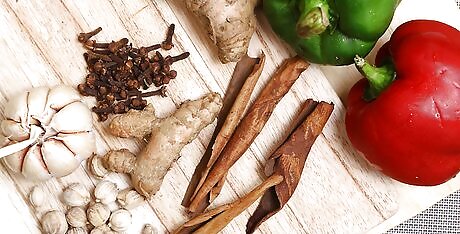
Give spices a try in your recipes. Like with herbs, adding a single spice (or a combination of them) can impart a very distinctive flavor profile to a dish, and tie its flavor profile to a particular global cuisine. Keep your pantry stocked with a supply of commonly-used spices. Cinnamon is a sweet, aromatic spice which is very popular in baking, especially in items such as apple pie and oatmeal cookies. It is also used in many Indian, Moroccan, and Mexican dishes. Paprika lends a burst of bright red color and a spicy burst of flavor to food. It is used in many Hungarian dishes, while also being popular in Spanish and Portuguese cuisines. Cumin is a popular spice used mainly to add flavor and color to curries. It is used in Middle Eastern, Mediterranean, and Asian cooking. Coriander is seed of the cilantro plant which has a lemony top note. It is commonly used in chili and curry dishes; it is used widely in many types of Latino, Middle Eastern, and Indian dishes. Ginger is a very versatile spice. When used fresh, it can add a sweet and spicy note to stir-fries, curries and roasted meats. In dried, ground form, ginger is often added to baked goods, such as ginger snaps.
How to Use Essential Cooking Techniques
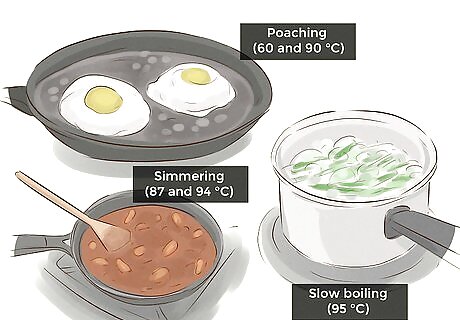
Cook foods in water at or near the boiling point. The temperature at which boiling occurs varies according to atmospheric pressure, but it is usually around 100 °C (212 °F). Boiling food involves immersing the food in boiling water until cooked. Poaching is the gentlest form of cooking in water, and is appropriate for cooking items like fish and eggs. It occurs at temperatures between 60 and 90 °C (140 and 194 °F). Simmering is probably the most common method of cooking in liquid, and is used for most stews and sauces. It occurs between 87 and 94 °C (189 and 201 °F). Slow boiling is the term used before water reaches a full rolling boil at 100 °C (212 °F). It is slightly more vigorous than a simmer, and occurs at roughly 95 °C (203 °F).
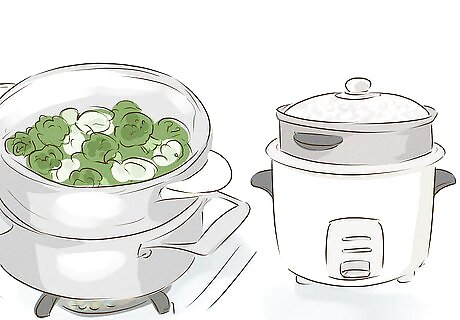
Steam delicate foods like vegetables and fish. Steaming uses the heat from the vapor of boiling water to cook food. It is a very gentle form of cooking, making it a great option for delicate foods such as fish and vegetables. Steaming is also a very healthy form of cooking, as unlike boiling, simmering, etc., the steam does not leach nutrients from the food. Steaming can be done using a traditional stacked bamboo or plastic steamer on the stovetop. Steamer inserts (which fit onto most pots) are also available at most kitchenware stores.

Braise tougher foods to make them juicy. Braising is a moist cooking method which can turn large, tough cuts of meat into a juicy, tender dish. It is achieved by first searing the meat (or tough vegetables) in a pan with fat, and then slow cooking it in liquid for several hours. To braise, you first need to sear the meat in fat in a hot pan. The meat is then placed in a heavy, oven-proof dish, a dutch oven, or a slow cooker. You will need to de-glaze the pan using wine, broth or some other liquid in order to scrape of small pieces of meat or fat that may have escaped. Then, add the de-glazing liquid to the meat dish, along with the rest of the cooking liquid (usually some combination of stock, wine or fruit juice), which should reach about halfway up the meat. Finally, cover the dish and place it in a preheated oven (or turn on the slow cooker) and leave to cook for up to six hours, depending on the type of meat used.

Sauté foods to quickly add flavor and color to them. Sautéing is a quick cooking method which involves cooking food in a pan, over high heat, in a small amount of fat. It imparts a lot of flavor to food, and is perfect for cooking tender cuts of meat and chunks of vegetables. With sautéing, the most important rule is that both the pan and the fat be heated to a high temperature before adding the food. Otherwise, the food won't cook properly—it will absorb some of the fat and stick to the pan. To check if the pan is hot enough, a good tip is to add a couple of drops of water to the pan - if they sizzle vigorously and evaporate within a couple of seconds, the pan is hot enough. Once the food is in the pan, it is important to keep it moving. The term sauté actually means "jump" in French, so keep tossing the food as you cook. This ensures that the food cooks evenly and that the pan stays hot. Small, tender cuts of meat respond well to sautéing, along with the majority of vegetables.

Pan-fry larger cuts of meat in a small amount of oil. Pan-frying is very similar to sautéing. It involves cooking food in a pan, using oil. However, pan-frying is typically used for larger pieces of meat—such as chicken breasts, steaks, pork chops and fillets of fish—which have not been cut into pieces. It is also done at a lower heat than sautéing, to ensure that the larger food items do not burn on the outside before they are cooked in the middle.
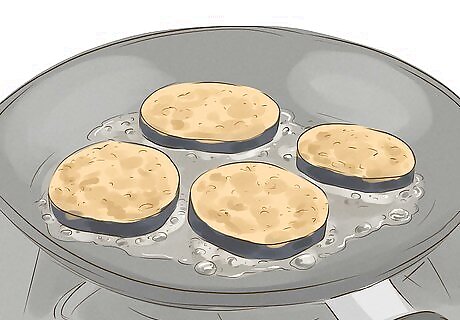
Shallow-fry foods like chicken or fish with oil in a pan. Shallow-frying is the same as pan-frying, except for the amount of oil used. With pan-frying the pan is simply coated thinly with oil, whereas with shallow-frying the oil typically reaches about halfway up the sides of the food being cooked. This method is used for cooking food such as fried chicken, battered shrimp and eggplant parmigiana.
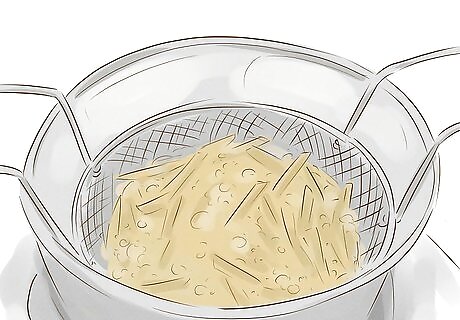
Deep-fry foods in oil to make them crispy on the outside. Deep-frying involves completely immersing the food in hot oil. With this type of frying, the food does not need to be flipped over halfway through cooking, as the coating of oil allows it to cook evenly on all sides. It is used to cook items such as battered foods, french fries and donuts.
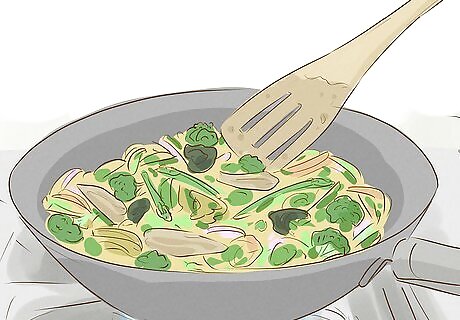
Stir-fry foods in a wok with a bit of oil. Stir-frying, a staple of Chinese cooking, is more or less the same as sautéing—the food is cut into small pieces and cooked in oil in a hot pan. The only difference is the type of pan used; stir-frying is done in a wok—which has a deep bowl with gently sloping sides and is made from thin metal. The shape of the wok allows you to control the cooking temperatures of different foods in the pan—the bottom of a hot wok’s cooking bowl is much hotter than the sides are.

Roast large cuts of meat and hardy veggies in the oven. Roasting is a dry heat cooking method, which involves cooking food, uncovered, on a roasting pan in the oven. It is most often associated with large cuts of meat—whole chickens and turkeys, lean cuts of pork, lamb and beef, fillets of fish—but also works very well with vegetables. A good roasting pan should be used, which is placed on the middle shelf of the oven. Convection ovens are perfect for roasting in, as they allow hot air to circulate, resulting in evenly browned meat and vegetables. Try recipes for roasting chicken, turkey, vegetables, beef, lamb, duck, potatoes, pork loin, and chestnuts.
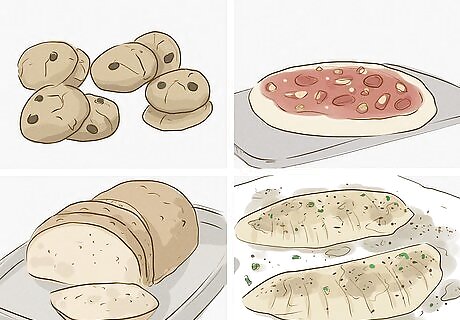
Bake cakes, breads, and other favorite foods in your oven. The major difference between baking and roasting is that roasting tends to be done at higher heats than baking. Also, baking is usually associated with food items that require batters and doughs, such as bread, cookies, pies and muffins. Avoid over-mixing doughs and batters. One of the most common mistakes people make when baking is over-mixing doughs and batters. Over-mixing activates the gluten in flour, which makes baked goods firm and chewy rather than light and crumbly. Don’t use liquid measuring cups to measure dry ingredients. Use a dry measurement cup with a flat top, which allows you to spoon the ingredient into the cup, then level it off with a knife. Try baking treats cookies, cakes, pies, muffins and breads, as well as potatoes, fish, pizza and chicken breasts.

Broil or grill to give meats or veggies an appealing char. Broiling and grilling are both dry cooking methods which involve heating food with an open flame. The only difference between broiling and grilling is that with broiling the heat source is above the food, whereas with grilling the heat comes from below. With grilling and broiling, the food needs to be placed quite close to the heat source. This means that the food cooks quickly on the outside, making grilling or broiling a good option for tender cuts of meat, chicken, and fish. Barbecuing is almost the same as grilling, except that the flame is produced by burning wood or coal, giving food a distinctive smoky flavor.
How to Master Go-To Recipes

Learn to make scrambled eggs. Place a sauté pan over medium heat and melt 2 teaspoons of butter in it. Whisk 2 eggs and 1 tablespoon (14.8 ml) of milk together in a bowl. Add the mixture to the pan and stir it with a wooden spoon or rubber spatula until it sets and separates into pieces. This is one of the most basic, yet most important cooking skills you need to learn on the road to becoming a great chef. Knowing how to boil an egg is also a good skill.

Practice making great rice. Soak 16 ounces (450 g) of rice in a bowl of water for 30 minutes, then drain and rinse it. Boil 2 cups (470 mL) of water (or a bit more or less, depending on the type of rice) in a pot, then add the rice. Turn the heat down to a low simmer, put the lid on, and let it cook for about 20 minutes. Rice accompanies a huge array of dishes, from a wide variety of cuisines, so it's important to know how to cook it right. Give pasta a try as well if you're tired of eating rice. It's easy to make!
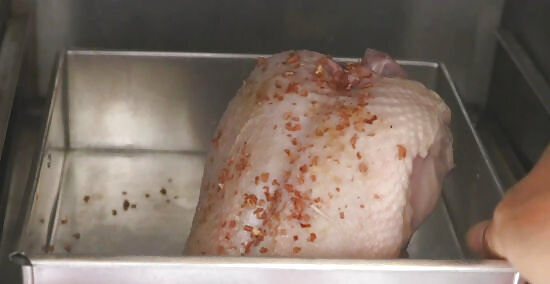
Get the hang of roasting a chicken. Pat dry a whole chicken and season it with salt, pepper, and your chosen herbs and spices. Place it in a roasting pan breast side down and put it in a preheated 350 °F (177 °C) oven for 45-50 minutes. Then flip it over and roast it for another 45-50 minutes. If you can roast a whole chicken, you are capable of making a meal to feed a whole family.
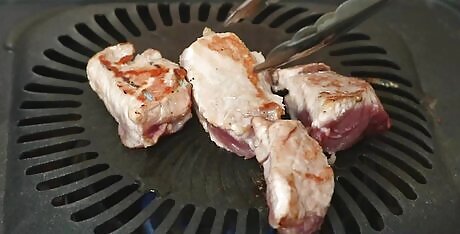
Grill a great steak for a delicious year-round dish. Buy a quality cut of meat that is at least 1 in (2.5 cm) thick. Season it with salt and let it come to room temperature. Create a cooler and hotter zone on your grill. Cook the steak on the cool side of the grill until it’s near the ideal temperature for your preferred level of doneness, then finish it on the hot side to add a great char. A perfectly grilled steak is one of the simplest, tastiest foods you can make. Serve it with a fresh green salad and some french fries and you're good to go!
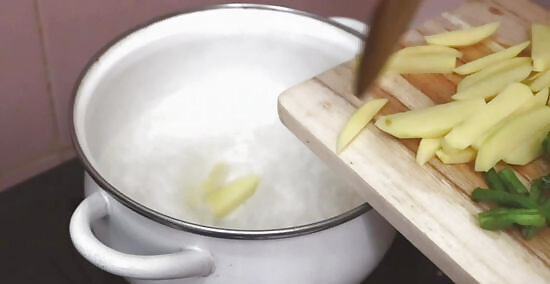
Steam veggies in a single pot for simplicity. If you don’t have a dedicated steamer, try just bringing 0.5 in (1.3 cm) of water to a boil in a large pot. Add your chosen veggies, cover the pot, and cook each veggie according to its recommended steaming time. Steaming vegetables preserves their color and nutrients, making it the healthiest way to cook them. Perfectly steamed vegetables will add a burst of color and increase the nutritional value of any meal.

Follow your recipe closely when baking a cake. This is not the time for experimentation or “winging it.” Use your recipe’s listed ingredients and measure them carefully. Unless instructed otherwise, grease your pan liberally, mix your batter only until the ingredients are incorporated, and check your baking cake regularly with a toothpick or probe thermometer for doneness. Learning how to bake a delicious cake is a valuable life skill, and a tasty one too! Experiment with chocolate cake, vanilla cake, coffee cake, lemon drizzle cake and red velvet cake.















Comments
0 comment